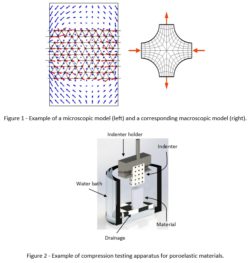An investigation of the Fluid Structure Interaction in articular cartilage across disparate scales
- Academic lead
- Greg de Boer (Mechanical Engineering)
- Co-supervisor(s)
- Michael Bryant (Mechanical Engineering), David Head (Computing), Mark Walkley (Computing), Alister Hart and Harry Hothi (Royal National Orthopaedic Hospital, University College London)
- Project themes
- Biomedical Flows, Underpinning Methods for Fluid Dynamics
Cartilage is comprised of microscopic fibres immersed in synovial fluid that is expelled under load, thereby increasing the load carrying capacity and reducing friction in natural joints. This remarkable property has been historically modelled at Leeds using the continuum equations of poroelasticity. However, the selection of relevant terms and coefficients in these equations is rarely justified
microscopically due to the disparity in scales between pores and the material. Predictive modelling is therefore at best semi-empirical, which limits the development of novel products and treatments related to cartilage and other materials exhibiting poroelasticity.
In this project, the student will help develop a 3D microscopic model of viscous fluid flow coupled to the elastic solid displacement of fibres and use this to determine the corresponding macroscale poroelastic continuum equations (Figure 1). Compression testing experiments will be conducted to provide insight into the relationship between microscopic and macroscopic parameters (Figure 2). This will be fundamental in validating model trends, ensuring that results are representative of conditions in natural joints. To ensure clinical relevance of outcomes, the supervisory team includes an orthopaedic surgeon and an orthopaedic engineer from UCL.

